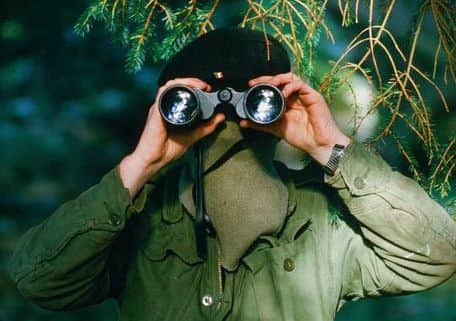An Iranian eye on the Troubles


On his way to international acclaim for his evocative, ominous and often unnerving images, Iranian photojournalist Kaveh Kazemi stood on the highways, byways, conflict regions and warzones of a packed atlas of countries.
He has photographed in the Lebanon, Azerbaijan, Iraq, Nicaragua, Colombia, Cuba, Afghanistan, Cyprus, Indonesia, Armenia and Syria.
Advertisement
Hide AdAdvertisement
Hide AdHe has covered some of the most significant global stories during the past four decades and has worked incognito, been detained, searched, questioned, shot at, blindfolded and had his skull fractured by a projectile in the Iranian revolution.


He has provided images for prestigious publications like Time, Newsweek, the New York Times and numerous other leading titles in a wide variety of languages.
Many tens of thousands of his photographs are with Getty Images, the world’s leading photographic agency, but “covering Ireland was instrumental in shaping me as an international photojournalist” 67-year-old Kazemi admits in his latest book entitled My Days in Troubled Ireland.
Dedicated to ‘the Irish people’, he launched the book last week in the Belfast Exposed gallery in Donegall Street.
Advertisement
Hide AdAdvertisement
Hide AdKazemi’s opening words about his work were “why Northern Ireland?”


His answer - he studied photography in England in the 1970s and watched the news about Northern Ireland every night on TV.
His “first exposure to armoured vehicles and riots” prior to the Islamic revolution “was the coverage of the Irish Troubles on British television channels.”
Kazemi’s memories of those reports were rekindled in 1981 when he was working in Iran and the revolutionaries changed the name of Winston Churchill Street in Tehran to Bobby Sands Street.
Advertisement
Hide AdAdvertisement
Hide AdThe name-change forced “a controversial address on the British Embassy located on that street” writes Kaveh, adding, “I made Northern Ireland my first self-commissioned assignment abroad.”


On his way here he met local soccer icon George Best in a coffee shop on London’s Kings Road and asked him for contacts in Belfast.
George directed him to people and places in east Belfast but when he arrived in 1985 Kaveh realised that he “was on the wrong side of the divide…where nothing was happening to show me there was a conflict going on.”
He decamped to the Falls Road where he was “approached by an inebriated man who asked me for a beer. I bought him one. Seeing the cameras around my neck he decided to return the favour by showing me around…I was on my way!”
Advertisement
Hide AdAdvertisement
Hide AdOne of the earliest scenes that he captured, which is probably the best way to describe many of his photographs, was taken in September 1985.
It’s one of the first images of 86 reproduced in his book and well-illustrates his eye for the juxtaposition of abnormality on normality…or vice versa.
Two Falls Road lads are playing enthusiastically on the footpath, oblivious, it seems, to a soldier with a gun on patrol beside them and an RUC armoured Land Rover passing by on the street.
Over the soldier’s shoulder a happy huddle of local folk are chatting in a shop doorway.
Advertisement
Hide AdAdvertisement
Hide AdThere’s litter, puddles, road signs, a leaning lamp post, a Chinese carryout, and shadows on the footpath - monotonously functional and ominously dysfunctional - an instant that’s at once happy, engaging, endearing, menacing and bleakly atmospheric.
Kaveh Kazemi knew he was standing in the perfect place for a powerful picture, but dominating his wish-list was “photographing Gerry Adams and Martin McGuinness.”
With help and directions from BBC journalist Paul Clements, now an author and travel writer, Kazemi proceeded to Londonderry.
But his two portraits were in Buncrana at an IRA funeral.
“Hello, I’m Kazemi from Iran,” he told them at the cemetery gates, after a taxi drive which he didn’t know had taken him into another country.
Advertisement
Hide AdAdvertisement
Hide Ad“You can’t believe how I felt at that moment,” he recounted at last week’s book launch, “I’d been looking for them for ages and I met them both at once!”
On his way back to Belfast he was stopped at an army road block but he got his pictures - McGuinness outside Sinn Fein HQ in Londonderry that same afternoon and Adams later in Belfast.
His book is a focused, wide angled, multi-coloured compilation of times past across Northern Ireland.
Dr Paisley and Peter Robinson in an Apprentice Boys parade in Londonderry; a Catholic priest silhouetted against an upstairs window pondering West Belfast’s Protestant neighbourhoods; a party in a pub; IRA trainees practising tactics in Donegal; a sectarian confrontation in Keady.
Advertisement
Hide AdAdvertisement
Hide AdI’ll leave the last word to Paul Clements, from his foreword to the book.
“Kazemi’s pictures are a meditation on a place at a particular period and are important, not simply from a journalistic perspective, but also from social awareness. Through his lens he captured unique and engaging portraits of people, from the countryside to cities.
“His sharp eye brings out the telling detail, whether a colourful mural or graffiti on a gable wall…The photographs also reflect social issues: a boy smoking beside wood gathered for a bonfire, young children playing near the rubble of a barricade or teenagers enjoying a party with a backdrop of violence.”
And there can’t be many books about Northern Ireland that are also written in Farsi!
My Days in Troubled Ireland by Kaveh Kazemi is available online at www.ideabooks.nl